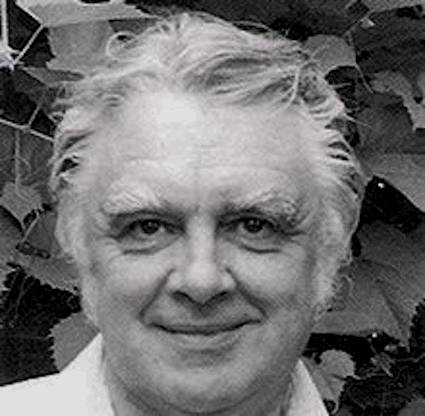Victor Witter Turner, 1920-1983

ヴィクター・W・ターナー
Victor Witter Turner, 1920-1983

解説:池田光穂
| Victor Witter Turner
(28 May 1920 – 18 December 1983) was a British cultural anthropologist
best known for his work on symbols, rituals, and rites of passage. His
work, along with that of Clifford Geertz and others, is often referred
to as symbolic and interpretive anthropology. |
ヴィクター・ウィッター・ターナー(1920年5月28日 -
1983年12月18日)は、シンボル、儀式、通過儀礼に関する研究で最もよく知られるイギリスの文化人類学者である。彼の研究は、クリフォード・ギアー
ツらの研究とともに、しばしば象徴人類学や解釈人類学と呼ばれる。 |
| Early life Victor Turner was born in Glasgow, Scotland, son to Norman and Violet Turner. His father was an electrical engineer and his mother a repertory actress, who founded the Scottish National Players. Turner initially studied poetry and classics at University College London. In 1941, Turner was drafted into World War II, and served as a noncombatant until 1944. During his three years of service he met and married Edith Brocklesby Davis, who was serving during the war as a "land girl". Their five children include scientist Robert Turner, poet Frederick Turner, and Rory Turner, an anthropology professor at Goucher College. Turner returned to University College in 1946 with a new focus on anthropology. He later pursued graduate studies in anthropology at Manchester University.[1][2] |
生い立ち ヴィクター・ターナーはスコットランドのグラスゴーでノーマン・ターナーとヴァイオレット・ターナーの息子として生まれた。父親は電気技師、母親はレパー トリー女優で、スコティッシュ・ナショナル・プレイヤーズを設立した。ターナーは当初、ユニヴァーシティ・カレッジ・ロンドンで詩と古典を学んだ。 1941年、ターナーは第二次世界大戦に徴兵され、1944年まで非戦闘員として従軍。3年間の従軍中、「ランドガール」として従軍していたエディス・ブ ロックルスビー・デイヴィスと出会い、結婚。二人の間には、科学者のロバート・ターナー、詩人のフレデリック・ターナー、ガウチャー・カレッジの人類学教 授ローリー・ターナーなど5人の子供がいる。 ターナーは1946年にユニバーシティ・カレッジに戻り、人類学に新たな焦点を当てた。その後、マンチェスター大学の大学院で人類学を専攻した[1][2]。 |
| Career Turner worked in Zambia (then Northern Rhodesia) as research officer for the Rhodes-Livingstone Institute. It was through this position that Turner started his lifelong study of the Ndembu people of Zambia. He completed his PhD at University of Manchester in 1955. Like many of the Manchester anthropologists of his time, he also became concerned with conflict. He developed the new concept of social drama in order to account for the symbolism of conflict and crisis resolution among Ndembu villagers. Turner spent his career exploring rituals. As a professor at the University of Chicago in the late 1950s, Turner began to apply his study of rituals and rites of passage to world religions and the lives of religious heroes. He and his wife converted to Catholicism in 1958.[3][4] Turner explored Arnold van Gennep's threefold structure of rites of passage and expanding theories on the liminal phase. Van Gennep's structure consisted of a pre-liminal phase (separation), a liminal phase (transition), and a post-liminal phase (reincorporation). Turner noted that in liminality, the transitional state between two phases, individuals were "betwixt and between": they did not belong to the society that they previously were a part of and they were not yet reincorporated into that society. Liminality is a limbo, an ambiguous period characterized by humility, seclusion, tests, sexual ambiguity, and communitas.[2]  Turner was also a committed ethnographer and produced work on ritual. He and his wife Edith L. B. Turner co-authored Image and Pilgrimage in Christian Culture (1978). |
経歴 ターナーはザンビア(当時は北ローデシア)でローズ・リビングストン研究所の研究員として働いた。この職を通じて、ターナーはザンビアのンデンブ族の生涯 研究を始めた。1955年、マンチェスター大学で博士号を取得。当時のマンチェスターの人類学者の多くがそうであったように、彼もまた紛争に関心を持つよ うになった。彼はンデンブ族の村人たちの紛争と危機解決の象徴性を説明するために、社会劇という新しい概念を開発した。 ターナーは儀式の探求にそのキャリアを費やした。1950年代後半にシカゴ大学の教授となったターナーは、儀式や通過儀礼の研究を世界の宗教や宗教的英雄の人生に応用し始めた。彼と彼の妻は1958年にカトリックに改宗した[3][4]。 ターナーは、アーノルド・ファン・ゲネップが提唱した通過儀礼の三重構造を探求し、限界段階に関する理論を拡張した。ファン・ゲネップの 構造は、前リミナル期(分離)、リミナル期(移行)、後リミナル期(再統合)で構成されていた。ターナーは、2つの相の間の過渡的な状態であるリミナリ ティにおいて、個人は「間に挟まれた存在」であり、以前所属していた社会には属しておらず、その社会に再統合されてもいないと指摘した。リミナリティとは 虚無のことであり、謙虚さ、隠遁、テスト、性的曖昧さ、コミュニタスによって特徴づけられる曖昧な期間のことである[2]。  ターナーはまた、熱心な民族誌学者でもあり、儀式に関する作品を発表した。妻のエディス・L・B・ターナーとの共著に『キリスト教文化におけるイメージと巡礼』(1978年)がある。 |
| Death Turner died on 18 December 1983 in Charlottesville, Virginia. After his death, his widow Edith Turner embarked on her own career as an anthropologist. She developed upon Victor's "anthropology of experience" with a publication on communitas.[5] |
死去 1983年12月18日、ヴァージニア州シャーロッツヴィルで死去。彼の死後、未亡人のエディス・ターナーは人類学者としてのキャリアをスタートさせた。彼女はヴィクターの「経験の人類学」を発展させ、コミュニタスに関する出版物を発表した[5]。 |
| Influence Author Chuck Palahniuk was quoted in The Believer as saying, "So often what I’m doing is dramatizing the writings of Victor Turner, who wrote a lot about liminal and liminoid events."[6] Turner's work on liminality and performance has strongly influenced developments in the field of Performance Studies,[7] particularly due to his friendship and professional collaboration with Richard Schechner with whom he explored the relationship between ritual and theater.[8] |
影響力 作家のチャック・パラニュークは『ビリーバー』誌で、「私がやっていることは、リミナルやリミノイド的な出来事について多くのことを書いたヴィクター・ ターナーの著作をドラマ化することであることが多い」と語っている[6]。リミナリティとパフォーマンスに関するターナーの研究は、パフォーマンス・スタ ディーズの分野の発展に強く影響を与えている[7]。 |
| Victor Turner Prize The Victor Turner Prize in Ethnographic Writing is awarded annually by The Society for Humanistic Anthropology (SHA). Eligible works are "published books in various genres including ethnographic monographs, narratives, essays, biographies, memoirs, poetry, and drama."[9] Kirin Narayan's Storytellers, Saints and Scoundrels: Folk Narrative in Hindu Religious Teaching (1989) was the first Victor Turner Prize winner in 1990.[10][11] |
ヴィクター・ターナー賞 ヴィクター・ターナー賞(The Victor Turner Prize in Ethnographic Writing)は、人文人類学会(SHA)が毎年授与している。対象となる作品は、「民族誌の単行本、物語、エッセイ、伝記、回想録、詩、演劇など、さ まざまなジャンルの出版物」[9]: 1989年)は、1990年に第1回ヴィクター・ターナー賞を受賞した[10][11]。 |
| Publishing The Forest of Symbols: Aspects of Ndembu Ritual (1967), Cornell University Press 1970 paperback: ISBN 0-8014-9101-0 Schism and Continuity in an African Society (1968), Manchester University Press The Drums of Affliction: A Study of Religious Processes among the Ndembu of Zambia (1968), Clarendon Press ISBN 0-8014-9205-X The Ritual Process: Structure and Anti-Structure (1969), Aldine Transaction 1995 paperback: ISBN 0-202-01190-9 Dramas, Fields, and Metaphors: Symbolic Action in Human Society (1974), Cornell University Press 1975 paperback: ISBN 0-8014-9151-7 Image and Pilgrimage in Christian Culture (1978), with Edith L. B. Turner (co-author), Columbia University Press 1995 paperback: ISBN 0-231-04287-6 From Ritual to Theatre: The Human Seriousness of Play (1982), PAJ Publications paperback: ISBN 0-933826-17-6 Liminality, Kabbalah, and the Media (1985), Academic Press The Anthropology of Performance (1986), PAJ Publications paperback: ISBN 1-55554-001-5 The Anthropology of Experience (1986), University of Illinois Press 2001 paperback: ISBN 0-252-01249-6 |
|
| https://en.wikipedia.org/wiki/Victor_Turner |
1920.05.28 英国グラスゴーに 生まれる
1939 ロンドンのユニバーシティ・カ レッジで古典と詩の勉強(第二次大戦で勉学から一時離れる)
1949 人類学で学士号、同年マンチェ スター大学でヨハネスブルグ生まれのマッ クス・グラックマン(Max Gluckmam, 1911-1975)に師事。
グラックマンはターナーにコンフリクト理 論と政治人類学を手ほどきする。(→拡大事例研究法)
マンチェスター学派
1950-54 中央アフリカ(当時:英 国植民地)にてンデンブの調査。
1955 Ph.D取得、マンチェスター 大学の講師となる。
1957 『分裂と持続』Schism and Continuity in an African Society: A study of Ndembu Village Life .の出版。(※この作品は拡大 事例研究法の最大の成果だと言われる)
1961 スタンフォード大学・高等行動 科学センター研究員(Fellow of the Center for Advanced Behavioral Sciences at Stanford University. )
1964 コーネル大学に転職(ウガンダ のギスを調査)
1968
『苦悩のドラム』(The Drums of Affliction: A study of Religious Processes among the Ndembu )を出版
シカゴ大学人類学および社会思想教授に転職(1963-75当時シカゴ大学で教鞭をとるハンナ・アーレントが同じ職場にいた[リンク] The Hannah Arendt Papers: Biographical Note )
キリスト教巡礼研究をはじめる
1983 死亡
リンク
【文献】
http://www.indiana.edu/‾wanthro/turner.htm(2002 年11年18日)
Lunda medicine and the treatment of disease / by Victor Turnerを収載
Betwixt and between : the liminal period in rites de passage / by Victor Turnerを収載
Ritual Aspects of Conflict Control in African Micropolitics.を執筆。